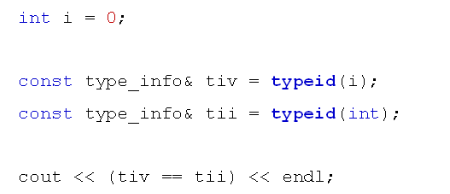1 C++中的类型识别
1.1 类型识别的基本概念
在面向对象中可能出现下面的情况:
- 基类指针指向子类对象。
- 基类引用成为子类对象的别名。

静态类型和动态类型的概念:
- 静态类型:变量(对象)自身的类型。
- 动态类型:指针(引用)所指向对象的实际类型。

1.2 利用多态得到动态类型
利用多态得到动态类型:
- 在基类中定义虚函数返回具体的类型信息。
- 所有的派生类都必须实现类型相关的虚函数。
- 每个类中的类型虚函数都需要不同的实现。
编程实验:动态类型识别
#include <iostream>
#include <string>
using namespace std;
class Base
{
public:
virtual string type()
{
return "Base";
}
};
class Derived : public Base
{
public:
string type()
{
return "Derived";
}
void printf()
{
cout << "I'm a Derived." << endl;
}
};
class Child : public Base
{
public:
string type()
{
return "Child";
}
};
void test(Base* b)
{
/* 危险的转换方式 */
// Derived* d = static_cast<Derived*>(b);
if( b->type() == "Derived" )
{
Derived* d = static_cast<Derived*>(b);
d->printf();
}
// cout << dynamic_cast<Derived*>(b) << endl;
}
int main(int argc, char *argv[])
{
Base b;
Derived d;
Child c;
test(&b);
test(&d);
test(&c);
return 0;
}
动态解决方案的缺陷:
- 必须从基类开始提供类型虚函数。
- 所有的派生类都必须重写类型虚函数。
- 每个派生类的类型名必须唯一。
1.3 typeid关键字
C++提供了typeid关键字用于获取类型信息:
- typeid关键字返回对应参数的类型信息。
- typeid返回一个type_info类对象。
- 当typeid的参数为NULL时将抛出异常。
typeid关键字的使用:
typeid的注意事项:
- 当参数为类型时:返回静态类型信息。
- 当参数为变量时:
- 不存在虚函数表时,返回静态类型信息。
- 存在虚函数表,返回动态类型信息。
编程实验:typeid类型识别
#include <iostream>
#include <string>
#include <typeinfo>
using namespace std;
class Base
{
public:
virtual ~Base()
{
}
};
class Derived : public Base
{
public:
void printf()
{
cout << "I'm a Derived." << endl;
}
};
void test(Base* b)
{
const type_info& tb = typeid(*b);
cout << tb.name() << endl;
}
int main(int argc, char *argv[])
{
int i = 0;
const type_info& tiv = typeid(i);
const type_info& tii = typeid(int);
cout << (tiv == tii) << endl;
Base b;
Derived d;
test(&b);
test(&d);
return 0;
}
参考资料:
来源:CSDN
作者:SlowIsFastLemon
链接:https://blog.csdn.net/SlowIsFastLemon/article/details/104318188